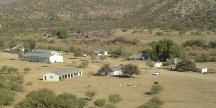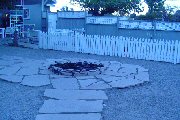| From Strugglingteens.com Visit Reports Wickenburg, Arizona
After viewing the cabins, we visited the 15 horses living on the Ranch campus before walking up to the "birdcage," a building where residents spend several hours a day studying the "Big Book" of Alcoholics Anonymous. When we walked in, the residents were in a circle discussing their patterns of addiction while working together to assist each other in finding potential solutions. We left the birdcage and headed up toward the main house where the men eat their meals. The entire ranch felt cozy and warm, and had a safe feeling that made me want to hang around all day. Because we'd arrived late, we only had time for a short visit at the Ranch before heading back to continue our tour of Gatehouse's main campus. Once back in Wickenburg, we drove over to the admissions building where six groups of parents were attending a family workshop. Gatehouse hosts family workshops at the student's four-month mark, then again every three months or so until graduation. Each group of families who participate in the workshops generally move through the program together. This allows the families to create their own support network throughout their young adult's treatment process.
The Gatehouse facility falls under the jurisdiction and scrutiny of the Arizona Department of Health Services, Division of Assurance and Licensure Services and Office of Behavioral Health Licensure. Gatehouse is listed in the non-licensed "Level 4 Transitional Agency" category, meaning they receive support to assist clients in managing crisis, or enhancing the client's independent living skills. Gatehouse is also licensed as an outpatient agency for its division of therapeutic and clinical services. Residents live at the main campus for approximately nine months after completing the ranch portion of the program, after which they are eligible for the four-month Internship Program. Upon completion of the Internship Program, if they express an interest, interns may apply as Junior Staff, which allows them to actively participate in all departments at Gatehouse. The main campus houses up to 70 residents where the young adults continue their work on the 12-Step program and begin working on academics. Both high school and college tracks are available to students. A couple of blocks up from the main campus are 25 additional horses the students care for and use in a variety of management tasks.
On the other side of the administration building sat several group homes for the young men, and I found it ironic that the men's houses were much cleaner than the women's. The men were also busily preparing dinner while showing off their newly acquired skills and singing along to Christmas carols on the radio. I was impressed with how candid and responsible the residents appeared, because everyone we talked with made excellent eye contact and seemed genuinely appreciative of the Gatehouse recovery program. After chatting with several students for a short while, we headed back to the administration building where we had a chance to talk with one of the main house-parents. As someone who had been sober for 13 years, she was the perfect mentor for the residents at Gatehouse Academy. I feel comfortable using Gatehouse Academy for the young adult who is struggling with chemical dependency issues and needs a supportive community to learn how to live a healthy life. After a wonderful day of visiting with the students, touring the campuses and chatting with various staff members, we climbed into the car and drove away from Gatehouse. It had been a relaxing day that left the feeling of hope for the future of the residents. © Copyright 2012 by Woodbury Reports, Inc. |


